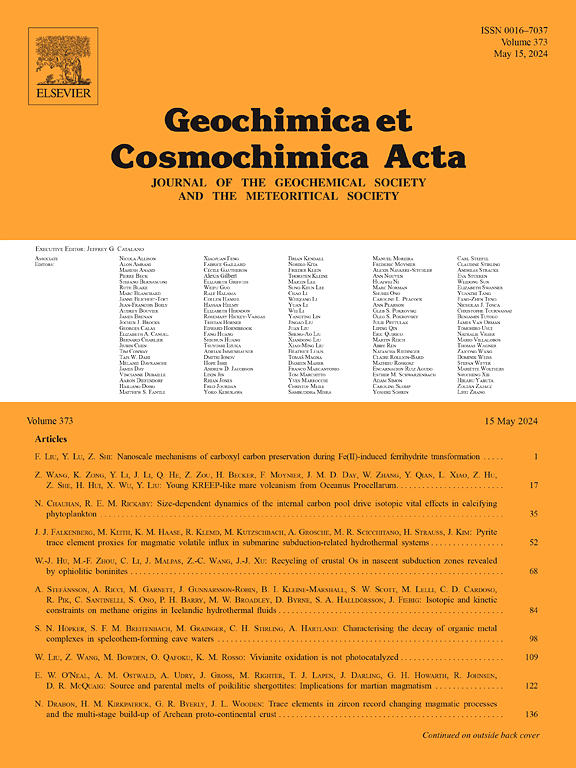On the origin and evolution of deuterium enrichment in type 1 and 2 chondritic organic solids
IF 4.5
1区 地球科学
Q1 GEOCHEMISTRY & GEOPHYSICS
引用次数: 0
Abstract
Rotationally resonant Deuterium Nuclear Magnetic Resonance spectroscopy (D MAS NMR) was applied to IOM isolated from a CR1 chondrite Grosvenor Mountains (GRO) 95577 and a CM2 chondrite (Murchison). It is shown that in IOM D strongly prefers the aliphatic hydrogen reservoir over the aromatic hydrogen reservoir. For GRO 95577, that has a bulk δD of 3303 ‰ (Alexander et al., 2010), the average δD value of the aromatic reservoir is 1740 ± 128 ‰ and the aliphatic reservoir is 4477 ± 105 ‰, i.e., D/H enrichments of 1.27 and 0.64, respectively, relative to the bulk. For Murchison IOM, that has a bulk δD of 811 ‰ (Alexander et al., 2010), the average δD of the aromatic reservoir is 512 ± 88 ‰ and the aliphatic reservoir is 1033 ± 64 ‰ i.e., D/H enrichments of 1.12 and 0.82, respectively, relative to the bulk. D-H exchange between D-enriched water and a type III kerogen reveals nearly equivalent D up take by both aromatics and aliphatics. Laboratory synthesis of IOM-like material in the presence of D2O reveals a high degree of deuteration with a strong preferential deuteration of the aliphatic hydrogen reservoir indicating that the δD of the water during IOM synthesis is the primary determinant of syn-IOM’s δD. The IOM in GRO 95577 and Murchison (FA and H/C × 100) lie on the molecular evolution line as defined by the IOM of the Tagish Lake clasts and Murchison IOM has experienced more molecular evolution relative to that exhibited by GRO 95577 IOM. A forward prediction derived from the D/H ratios for the aliphatic and aromatic hydrogen reservoirs in Murchison and GRO 95577, relative to their bulk D/H ratios, derived from D MAS NMR, is applied to explain the origin of the Tagish Lake trend of δD vs molecular evolution (H/C × 100). The results of this forward prediction suggest that the Tagish Lake isotopic trend results from a combination of molecular evolution (loss of predominantly aliphatic H and D) and partial D-H exchange with D depleted chondritic water during a short-term hydrothermal alteration event. Such events may be faithfully identified in chondritic organic solids and be a common occurrence, but not necessarily revealed in the mineralogy of type 1 and 2 carbonaceous chondrites.
关于1型和2型软玉有机固体中氘富集的起源和演变
旋转共振氘核磁共振波谱(D MAS NMR)被应用于从 CR1 雪岩 Grosvenor Mountains (GRO) 95577 和 CM2 雪岩 Murchison 分离出来的 IOM。结果表明,在 IOM 中,D 强烈偏好脂肪族氢库而不是芳香族氢库。对于体积δD 为 3303 ‰ 的 GRO 95577(Alexander 等人,2010 年),芳香族储氢层的平均δD 值为 1740 ± 128 ‰,脂肪族储氢层为 4477 ± 105 ‰,即相对于体积,D/H 富集度分别为 1.27 和 0.64。对于体积δD 为 811 ‰ 的 Murchison IOM(Alexander 等人,2010 年),芳香族储层的平均δD 为 512 ± 88 ‰,脂肪族储层的平均δD 为 1033 ± 64 ‰,即相对于体积,D/H 富集度分别为 1.12 和 0.82。富集 D 的水与 III 型角质之间的 D-H 交换显示,芳香族和脂肪族对 D 的吸收几乎相等。在 D2O 存在下实验室合成的 IOM 类物质显示出高度的氘化,脂肪族氢库具有强烈的优先氘化,这表明在 IOM 合成过程中水的δD 是决定合成 IOM 的δD 的主要因素。GRO 95577和默奇森的IOM(FA和H/C ×100)位于塔吉什湖碎屑岩IOM所确定的分子演化线上,与GRO 95577 IOM相比,默奇森IOM经历了更多的分子演化。根据 D MAS NMR 得出的 Murchison 和 GRO 95577 脂肪族和芳香族储氢器的 D/H 比值(相对于它们的体积 D/H 比值)进行前瞻性预测,以解释塔吉什湖 δD 与分子演化(H/C ×100)趋势的起源。这一前瞻性预测的结果表明,塔吉什湖的同位素趋势是分子演化(主要是脂肪族 H 和 D 的损失)和在短期热液蚀变事件中与 D 贫化的软玉水进行部分 D-H 交换的综合结果。这类事件可以在软玉有机固体中被忠实地识别出来,并且是一种常见现象,但不一定会在1型和2型碳质软玉的矿物学中被揭示出来。
本文章由计算机程序翻译,如有差异,请以英文原文为准。
求助全文
约1分钟内获得全文
求助全文
来源期刊

Geochimica et Cosmochimica Acta
地学-地球化学与地球物理
CiteScore
9.60
自引率
14.00%
发文量
437
审稿时长
6 months
期刊介绍:
Geochimica et Cosmochimica Acta publishes research papers in a wide range of subjects in terrestrial geochemistry, meteoritics, and planetary geochemistry. The scope of the journal includes:
1). Physical chemistry of gases, aqueous solutions, glasses, and crystalline solids
2). Igneous and metamorphic petrology
3). Chemical processes in the atmosphere, hydrosphere, biosphere, and lithosphere of the Earth
4). Organic geochemistry
5). Isotope geochemistry
6). Meteoritics and meteorite impacts
7). Lunar science; and
8). Planetary geochemistry.
 求助内容:
求助内容: 应助结果提醒方式:
应助结果提醒方式:


